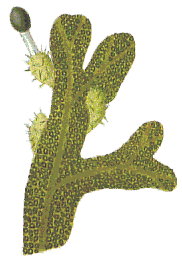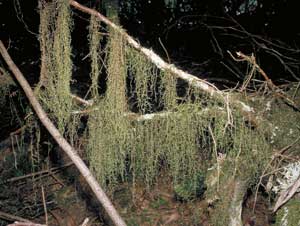
Ecology
Habitats
Many people think of the lush, green tropics as the natural haunts of the bryophytes. In fact you can find them from the cold arctic and antarctic to the hot deserts of the world and from sea level to alpine peaks. That's not to say that bryophytes are found everywhere in the world. Yes, they are found in the arctic and antarctic, but not on ice. Yes, various bryophytes can grow on sand and in deserts but not on the highly mobile sand dunes in desert or coastal regions. An example of a bryophyte that is found in quite harsh habitats is the thallose liverwort Monocarpus sphaerocarpus ![]() , found on saline or gypsum-rich soils. It is known from Western Australia, South Australia and, most notably from the dry north-west of Victoria, and is also found in South Africa.
, found on saline or gypsum-rich soils. It is known from Western Australia, South Australia and, most notably from the dry north-west of Victoria, and is also found in South Africa.
This page and its subsidiary pages aim to give you some answers to the question: "Where can I find bryophytes?" You won't find an exhaustive account of the numerous habitats in which bryophytes are found but you will find a detailed discussion of some habitats in order to illustrate various challenges to and adaptations by the bryophytes to various conditions. As you read through these habitat pages you will also encounter numerous substrates, that is, what bryophytes grow on![]() .
.
There are various factors that influence the distribution of bryophytes and a few examples are: climate (including aspects such as yearly temperature and rainfall patterns); substrate chemistry (e.g. whether it's alkaline or acidic); physical factors such as surface texture, degree of shading; pollution level. Take a moss such as Papillaria flavolimbata, shown here growing as a well-developed curtain from the branch of a rainforest tree. Such a curtain has a large surface area-to-volume ratio and so is very effective at trapping atmospheric moisture. The necessary humidity need not come from rainfall since moss curtains are also very effective at trapping moisture carried by fogs or mists. Spiders' webs give a more commonly-seen example of the effectiveness of the water-trapping potential of such curtains. Who hasn't seen spiders' webs on foggy mornings, the strands loaded with numerous tiny beads of water? However, those moss curtains also lose water fairly rapidly and this physical growth form would be a handicap in predominantly dry areas. Not surprisingly such curtain-like mosses are found in areas with high rainfall or with frequent fogs.
There are species that are restricted to very specific habitats or substrates, but others are found in more than one habitat or on several substrates. In some cases that's not too surprising. Well-rotted wood need not be much different to rich, organic soil in terms of texture, chemistry and water-holding capacity. It would therefore be no surprise to find some species growing on both soil and well-rotted wood. There are some species of bryophytes that will only ever be found on alkaline substrates, others must have acidic substrates and some will tolerate both. A rock-inhabiting species that requires alkalinity could be found on an alkaline rock such as limestone, but never on an acidic rock (such as basalt, for example), You could also find such a species on soil, but only on alkaline soil. You might find the same species in an urban area on surfaces such as concrete walls or concrete roof tiles, since concrete is also alkaline. If you had a clay brick wall you may find lime-loving bryophytes on the mortar between the bricks, but not on the bricks themselves. Of course, if you're a lime-loving bryophyte, then old bones also make a suitable substrate.
Broad types of habitats, such as rainforests, grasslands and deserts are significant but it is also very important to look at the small scale when it comes to bryophytes. You've already seen a hint of this in the previous paragraph. Within a single broad habitat (such as "woodland" for example) there are invariably numerous micro-habitats. Here's a log, a tree, a boulder, a depression – all in this one woodland area and each creating distinct surfaces, levels of exposure, chemistry, patterns of water flow and so on. In other words, different MICRO-HABITATS which appeal to different bryophytes. Returning to the example of Monocarpus sphaerocarpus, given at the top of this page, in the Australian saline areas in which this species occurs it is often found growing in the shade of salt-tolerant shrubs and where the ground is slightly raised – and hence often a little less salty than the lower-lying areas.
Many habitats, apart from salt flats, present considerable challenges to day-to-day survival and bryophytes have developed various strategies to overcome them. An obvious challenge in arid areas is water, which is typically scarce and unpredictable – but there are many bryophytes in arid areas, with various survival strategies. While many people will think of deserts when the word "arid" is mentioned the arctic and antarctic can also be considered arid, since free water is often rare in the sub-polar areas. One way to overcome the challenge is to grow in protected areas, in rock crevices or at the bases of boulders or shrubs thereby getting some protection from drying winds. Many of the polar or desert mosses that grow in more exposed areas grow as dense colonies in carpet or cushion form, which helps to protect against drying winds and also helps retain water. For more on this subject there's a separate page about BRYOPHYTES IN ARID AREAS, Incidentally, you can find some of the arid area survival strategies in places you might not initially consider arid. Think of a street tree in any temperate zone city - far from the alps, poles and deserts of the world. The trunk of such a tree is also an arid environment, for it is exposed to the sun and the drying winds. If there are bryophytes on that tree they are likely to be growing in fissures in the bark or as small, dense cushions. This also raises the subject of BRYOPHYTES IN URBAN AREAS and, as that link shows, urban areas provide both opportunities and challenges.
A field that is ploughed annually presents its own challenges. It's likely that many gametophytes in such a field would be buried or fragmented during the annual ploughing, with relatively few surviving intact from one year to another. Effective strategies for occupying such a habitat are the rapid development of spores or vegetative propagules or the production of hardy resting organs such as tubers (or rhizoidal gemmae). Habitats that are disturbed and re-created on a more-or-less regular basis are the subject of the CYCLIC, EPHEMERAL HABITATS page.
Many people will have seen lush bryophyte colonies at the margins of streams or lakes, on boulders in streams and even on the rock faces of waterfalls. Some of those species can also tolerate drier habitats while others cannot survive away from an aquatic environment. The bryophytes in such sites are frequently splashed with water and, from time to time, may even become submerged for relatively short periods. However most people are unaware that there are also permanently submerged bryophytes and some species that float on the water's surface. The water's edge, the water's surface and the varying depths beneath the surface provide a variety of micro-habitats for AQUATIC BRYOPHYTES. Bogs are also home to many species of bryophytes, with SPHAGNUM probably the best known genus of boggy areas.
Sand is both a substrate and a challenge to many terrestrial bryophytes which, in sandy areas may easily be covered by windblown sand grains. Yet bryophytes do grow on sand, even on sand dunes except those that are highly mobile, as noted in the opening paragraph of this page. The accompanying photo shows the moss Tortella cirrhata (right) growing with other plants on a small, near coastal sand dune. The BRYOPHYTES ON SAND CASE STUDY gives some more information about bryophytes in sandy areas.
![An Australian Government Initiative [logo]](/images/austgovt_brown_90px.gif)



